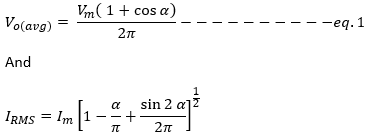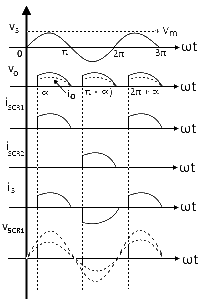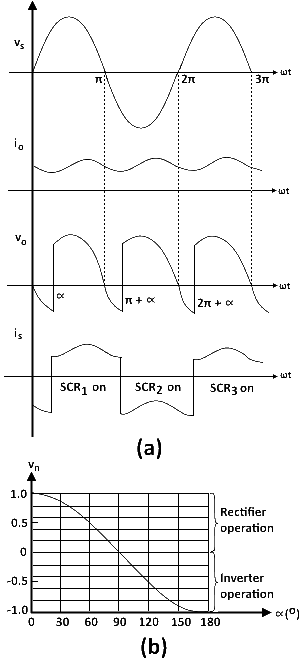Full-wave Controlled Center-tap Rectifiers
To build a controlled rectifier or a phase controlled rectifier, the diodes in the rectifier circuits are replaced by SCRs. These circuits produce a variable DC output voltage whose magnitude is varied by phase control, that is, by controlling the duration of the conduction period by varying the point at which a gate signal is applied to the SCR.
Unlike a diode, an SCR will not automatically conduct when the anode-to-cathode voltage becomes positive a gate pulse must be provided. If we adjust the delay time of the gate pulse, and if this process is done repeatedly, then the rectifiers output can be controlled. The process is done repeatedly, then the rectifiers output can be controlled. This process is called phase control.
Controlled rectifiers, or converters, as they are generally called, are broadly classified into full-controlled and half-controlled types. The full-controlled or two quadrant type uses SCRs as the rectifying devices. The DC current is unidirectional, but the DC voltage may have either polarity. With one polarity, the flow of power is from the AC source to the DC load this is called rectification. With a reversal of the DC voltage by the load, the flow of power is from the DC source to the AC supply; this process is called inversion.
If we replace half of the SCRs with diodes, the circuit is classified as a half-controlled or semi converter circuit. Such a circuit also allows the average value of the DC output voltage to be varied by phase control of the SCR. However, the polarity of the DC output voltage and the direction of the current cannot change, that is, the flow of power is from the AC source to the DC load. Converters of this type are also called one-quadrant converters.
Controlled rectifiers provide DC power for various applications, such as DC motor speed control, battery charging, and high-voltage DC transmission. Phase control is suited for frequencies less than 400 Hz, typically 60 Hz. The main drawback of phase control is radio frequency interference (RFI). The chopped half-sine wave produces strong harmonics that interfere with radio, television, and other communication equipment.
With a Resistive Load
Figure 1 shows the basic arrangement of a single-phase, center-tap controlled rectifier with a resistive load. Phase control of both the positive and the negative halves of the AC supply is now possible, thus increasing the DC voltage and reducing the ripple compared to those of half-wave rectifiers.
During the positive half-cycle of the input voltage, SCR1 is forward-biased. If we apply the gate signal at α, SCR1 turns on. The output voltage (vo) follows the input voltage. The load current (io = vo / R) has the same waveform as the load voltage. At π, when the current through SCR1 becomes zero, it turns off naturally. During the negative half-cycle, SCR2 is forward-biased. SCR2 is fired at (π + α). The output voltage again follows the input voltage. The current through SCR2 becomes zero at 2π, and it turns off. SCR1 is fired again at (2π + α) and SCR2 at (3π + α), and the cycle repeats. Figure 2 shows the resulting voltage and current waveforms.
The average value of the load voltage is twice that given by equation 1


With an Inductive load (RL) Load
Figure 3(a) shows the waveforms for voltage and current, assuming a highly inductive load so that the load current is continuous (i.e. present always). SCR1 conducts for 180o from α to (π + α), and the load voltage follows the input voltage. At (π + α) SCR2 is fired. SCR1 now turns off, since the supply voltage immediately appears across it and applies a reverse bias. SCR2 now conducts for 180o form (π + α) to (2π + α) and supplies power to the load.
The average value of the load voltage is given by
The output voltage is at its maximum when α = 0o, zero when α = 90o, and its negative maximum when α = 180o. the normalized average output voltage is:

The control characteristic (the plot of Vn as a function of α) is shown in Figure 3(b).
The RMS output voltage is given by
Vo(RMS) = VS(RMS)
With Freewheeling Diode
A freewheeling diode connected across the inductive load (as shown in figure 4(b)) modifies the voltage and current waveforms of Figure 3(a). As the load voltage tends to go negative, the FWD becomes forward biased and starts conducting. Thus, the load voltage is clamped to zero volts. A nearly constant load current is maintained by the freewheeling current through the diode.
The freewheeling diode carries the load current during the delay period α when the SCRs are off. Therefore, the current through the FWD (D) is given by:
